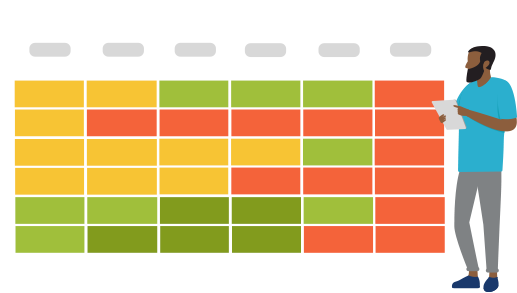Measuring resource utilization can help you plan your people efficiently and effectively, leading to productive teams.


Measuring resource utilization can help you plan your people efficiently and effectively, leading to productive teams.

Resource utilization is the measure of how much work your people are doing at any given time, including work that is forecasted but not yet begun. Typically, resource utilization is best measured in FTE, or full-time equivalent.
Resource utilization is an important metric to analyze employees after work has been assigned and after work has been completed. This metric differs from resource allocation, which is a process to staff a project and manage the resources put toward a project – before the work has been completed. Resource allocation is the action that a Resource Manager takes to find a resource utilization rate. Resource allocation is the actual assignment of work, and it can only be successful if assumptions for resources are built upon proper analysis from prior work. That is why resource utilization is so important, as it examines the effectiveness of each resource both historically and how effective a resource can be in the future.
Understanding historical resource utilization helps companies learn from how work is being done to plan better for future projects. By measuring resource utilization and working toward an ideal resource utilization rate, you can learn about issues that have arisen or might arise with important work and projects. Resource utilization can reveal why a project may be behind on schedule, as it can easily measure if resources are overutilized. It can also predict what will happen in the future, such as seeing a forecasted resource utilization rate too high can indicate that a team will be overworked in the future. In this instance, the Resource Manager will need to work with project and portfolio leadership to prioritize certain projects over others or hire additional people to complete the work.


These are all important parts of a strategic resource management strategy, but they all have unique aspects and are not the same.
Capacity planning is the step taken at the onset of a new project or strategic initiative that involves determining if an organization has the capacity and skill sets among its people to fulfill the demand for projects currently in the queue and in planning stages. This strategic planning step can be done months or years ahead of the planned work, and takes into consideration time, skills and resource demand. Capacity planning looks at the funnel of work and priorities in advance of the work actually getting done, or even assigned.

Demand planning helps gather and prioritize new ideas, projects and needs throughout the portfolio. Once a company has defined its vision and overall strategy, demand planning is used to continue to address that strategy while collecting new ideas and assessing how they fit into the current vision. It’s where ideas are taken and fit into the workflow, resources are requested for the project, and needed skills of the resources are factored into the needs of the project.

Resource forecasting is when you align your current talent with your strategic business initiatives. It’s about understanding the skills and people within your organization, and your company’s strategic goals. A Resource Manager compares supply and demand to understand the gaps between them, which can mean additional training for employees to gain skills needed for work, or additional hires to get the work completed.

Skills management involves understanding what skills will be required of the resources assigned to the project and who within your organization possesses those skills. It’s necessary for any Resource Manager to understand the skills of all resources to ensure the right resources are assigned and will bring value and skills to the project. Skills management needs to be incorporated into the planning process.

Calculating a resource utilization rate starts with determining what an individual’s capacity is over a set period of time. A week is a standard time period. You must also have information on how much time the person is expected to work on a project or task. The resource utilization rate formula is planned hours divided by capacity hours. Planned hours can also be referred to as working time or billable hours.
For example, an engineer is assigned 32 hours of work across four projects during one week. That engineer has 40 hours of capacity in a week to give. Using the resource utilization rate formula, divide 32 by 40, which gives a resource utilization rate of 0.8, or 80%. This means that the engineer is 80% utilized.

The resource utilization rate formula can be used to measure an individual resource, or a team as a whole. Additionally, the formula can be expanded to look at longer time frames, such as the length of the project, a quarter, or even annual planning. As mentioned earlier, looking at resource utilization across a longer time period such as the entire portfolio can help with future planning for resource allocation.

When you plan your team’s time intentionally, you are setting your people and organization up for success. The benefits of resource utilization include:

Resource utilization prevents your employees from getting bored from too little work, or conversely, getting burnt out from too much work.

Companies can see a better return on investment when implementing an ideal resource utilization rate because it creates happier employees and more efficient project completion.

Resource utilization allows Project Managers and Resource Managers to be agile when resource bottleneck issues arise.
It’s important to note that optimizing for resource utilization does not mean trying to achieve a 100% utilization rate for a resource or team. Generally, a rate of 80% is considered ideal, and any more than that can lead to employee burnout. When optimizing resource utilization, it’s important to ensure you are not expecting employees to achieve 100% utilization. Expecting every minute of an employee’s 8-hour day to be time put toward a project is unrealistic and doesn’t factor in time for task switching, transitioning between projects, unplanned tasks, and typical employer expectations such as internal meetings, reports and emails.

If resource utilization is not used properly or is not incorporated into overall resource portfolio management decisions, it can have a detrimental effect on employees, and in turn, projects and strategic priorities not being met.
A key component of optimizing productivity is avoiding burnout. If a resource is spending more than 80% of their time on project work, and does not feel they have sufficient time to prepare for tasks, pursue professional development opportunities, or simply to transition between projects, they can easily feel overused and develop burnout. Additionally, optimizing productivity through resource utilization is important to avoid bored employees, unfinished or rushed work, or missed deadlines.


It’s important for Resource Managers to understand their ideal resource utilization rate so they can more accurately gauge the progress of their projects and make educated decisions about how a project will be completed. It’s important to understand if an employee’s workload is manageable, as that is a critical factor in the larger picture of whether a project or larger initiative can get completed on time and within budget. Decisions such as whether to outsource work, how many new hires are needed for the coming year, budgeting and forecasting, and even employee performance reviews rely on the analysis that resource utilization rates reveal.
Tools such as Excel can help track the resource utilization rate once information is gathered from Project Managers and employees about how they are spending their time. This tactic can lead to an incomplete picture due to multiple file versions and siloed information. A resource management solution such as Tempus Resource can track employees’ skills, roles and time available, paired with the demands of the organization, to better understand what’s needed to get work done. Tempus Resource’s custom platform gives better visibility into resource utilization to achieve more comprehensive resource portfolio management.

Measuring resource utilization can help you plan your people efficiently and effectively, leading to productive teams.
Tempus Resource by ProSymmetry is a purpose-built, resource portfolio management solution providing many Fortune 500 companies with resource forecasting and capacity planning solutions that inform strategic decisions and improve business agility. Tempus gives Resource Managers actionable intelligence, cutting-edge analytics, and real-time scenario analysis. To schedule a demo of Tempus, click the button below.